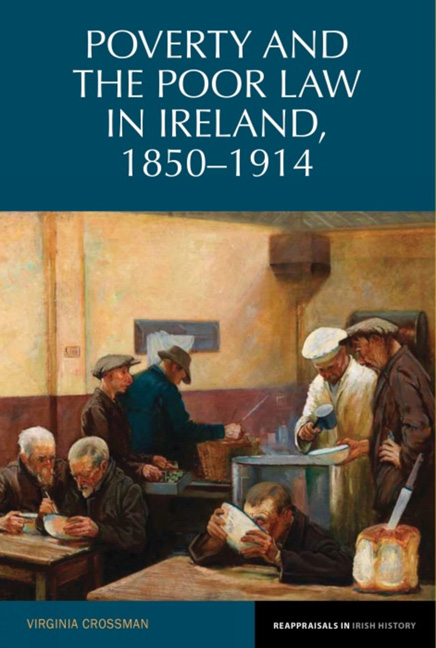Book contents
- Frontmatter
- Contents
- List of Figures
- List of Tables
- List of Maps
- Acknowledgements
- Introduction
- Chapter 1 Concepts of Poverty and Poor Relief
- Chapter 2 Context and Trends
- Chapter 3 Outdoor Relief
- Chapter 4 The Workhouse
- Chapter 5 The Sick, Infirm and Lunatics
- Chapter 6 Single Mothers and Prostitutes
- Chapter 7 Mendicancy and Vagrancy
- Conclusion
- Note on statistics and Sources
- Bibliography
- Index
Conclusion
- Frontmatter
- Contents
- List of Figures
- List of Tables
- List of Maps
- Acknowledgements
- Introduction
- Chapter 1 Concepts of Poverty and Poor Relief
- Chapter 2 Context and Trends
- Chapter 3 Outdoor Relief
- Chapter 4 The Workhouse
- Chapter 5 The Sick, Infirm and Lunatics
- Chapter 6 Single Mothers and Prostitutes
- Chapter 7 Mendicancy and Vagrancy
- Conclusion
- Note on statistics and Sources
- Bibliography
- Index
Summary
The poor law never acquired popular legitimacy in Ireland. It was too expensive, too inefficient, too associated with British rule and with memories of the Famine. Following independence, the workhouse system in the south was swept away as part of a reorganisation of local government and social welfare that saw the abolition of poor law boards and workhouses, and the introduction of home assistance administered by boards of health and public assistance. Workhouse buildings were generally converted into hospitals or county homes. The latter provided institutional care for the elderly and infirm, and chronic invalids, together with, in some cases, lunatics, epileptics, single mothers and children. The workhouse system and its administrators could be safely consigned to the past, one chapter in the larger story of oppression and misrule. But as this study has shown, the system of poor relief that operated under the Irish poor law was a system that reflected the culture and values of Irish society. If the system was harsh and limited, this was not only because the principles enshrined in the legislation were harsh, but also because its administration reflected popular notions about entitlement and eligibility, the belief that relief should be restricted to local people and denied to strangers, and that anyone capable of working should be expected to do so. Many of the assumptions made about the Irish poor law have been shown to be false. The poor law was not synonymous with the institution of the workhouse. By the end of the nineteenth century, substantial numbers of people were being relieved in their own homes. Only a minority of relief recipients were forced to enter the workhouse. Workhouses accommodated few families and few able-bodied people. They could be difficult to access and difficult to remain in for any length of time. They were, however, important sites of medical treatment and care.
Much of the detailed discussion within this study has focused on systems and procedures. These have not been examined in isolation, however, but in the context of their human consequences: how they impacted on individuals. We have seen how disapproval of certain lifestyles contributed to the deaths of Rosanna D., Bridget K. and John L. Information on individual paupers derives primarily from investigations into and discussion of cases of mismanagement or neglect. In one sense such cases are the tip of the iceberg.
- Type
- Chapter
- Information
- Poverty and the Poor Law in Ireland, 1850–1914 , pp. 226 - 229Publisher: Liverpool University PressPrint publication year: 2013



